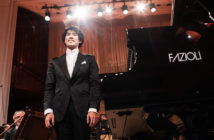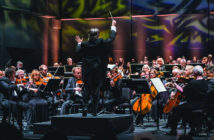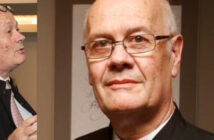
This page is also available in / Cette page est également disponible en:
![]() Francais (French)
Francais (French)
Johannes Brahms was in a foul mood one evening while dining at the house of the pianist Ignaz Brüll, a popular host in Vienna in the 1880s. “Don’t you think it strange,” he blurted out, “that a Jew should set a text of Martin Luther’s to music?” Everyone present was meant to hear him, including the Jew in question, Brahms’s long-suffering friend and colleague, Karl (or Carl) Goldmark. While this was far from the first social occasion that Brahms spoiled with an insensitive remark, the composer’s biographer Jan Swafford deems it to be “the only time on record when Brahms sounded an antisemitic note.”
Was the comment anti-Semitic or did it merely sound anti-Semitic? In his memoirs, from which the quotation is taken, Goldmark reasons that Brahms was expressing displeasure at his own failure to notice the Luther text, Wer sich der Musik erkiest, “with its evangelical appeal of which he could have made good use.”
The larger question raised by the comment is how or whether Goldmark (1830-1915) was influenced as a composer by his Jewish ancestry and upbringing. It is an issue worth exploring as the Hungarian State Opera brings Goldmark’s greatest hit, Die Königin von Saba (The Queen of Sheba), to the New York on Oct. 31 and Nov. 2, as part of a guest residency at the David H. Koch Theatre of Lincoln Center.
Few Jews were more assimilated than Goldmark, as his memoirs, Notes from the Life of a Viennese Composer (translated by his niece, Alice Goldmark Brandeis) make clear. Only in his report of the Brahms episode does Goldmark use “Jew” or any derivative of this word. Even oblique references to his Jewish upbringing are hard to find in the 238-page text, which the composer started at age 80 in 1910 or 1911 and left unfinished at his death in 1915.
Were the composer’s father not described in the second sentence as “the cantor and notary of the community” in Keszthely, the Hungarian town where Goldmark was born in 1830, an inattentive reader would have to wait until the party at Grüll’s to encounter an unequivocal reference to the composer’s ancestry. To all appearances the autobiographical narrative concerns the experiences of a Viennese with national ties to Hungary but no link to Jewish thought or practice.
There is some basic information about his childhood. We learn that when Goldmark was four, his family moved to the town of Deutschkreutz in Burgenland, then a Hungarian territory. Goldmark says he “learned to speak pure German” as a teenager in Vienna, where he stayed with his brother Josef, a medical student on the cusp of a career as an 1848 revolutionary.
Silent on Judaism, Goldmark does not hesitate to document his fascination with the trappings of Christian liturgy. Goldmark tells us that he was confirmed in his calling as a composer by the enchanting sounds of “the Holy Mass” emanating from a rural church near a chestnut grove within hiking distance of his home in Deutschkreutz.
“At this moment my fate and future were decided and my career settled,” he writes. “I was to be a musician, and strangely enough it came about through the Catholic Church.” In Vienna the young student accepted the advice of his teacher Leopold Jansa to hear good music at low cost by attending services and “never missed a Sunday at the Imperial Court Chapel.”
There are no parallel expressions of interest in Jewish community life or religious practices, much less any statement of intent to pursue a Jewish agenda as a composer. Yet Ferdinand Scherber, the former director of the music collection of the Hofbibliotek in Vienna, confidently extols Goldmark as one of the first exponents of “Jewish-oriental-exotic music.” Exceeding Scherber in his enthusiasm for this line of thinking is Max Graf, a friend and supporter of Sigmund Freud, who describes Goldmark in his own memoirs as “the most perfect representative of the Jewish personality” he had met, excepting Freud, Einstein and the Chief Rabbi of Austria, Z. H. Chajes. Goldmark’s wisdom, to Graf, was “rabbinical wisdom.”
As for the Jewish genesis of Die Königin von Saba, this was incontrovertible. “Its Biblical subject,” Graf declares, “expressed all the forces of his Jewish soul.” Graf says he solicited the opinion of Chajes on this point and was told: “Goldmark did not have to go to the Orient. The Orient was in his soul.” According to Graf, Chajes “repeated this profound sentence” at the dedication of Goldmark’s tomb.
We cannot know whether the composer rolled in his grave but we do know from Graf that Goldmark, by all accounts the most peaceable of men, became incensed at any attempt to link the success of Die Königin von Saba with his Jewish birth. “It seems the Jews consider my Queen of Sheba a national opera,” is how Graf recounts Goldmark’s “furious” reaction to this proposal. “But in composing this work, I had no other interest than to write music to an interesting and efficient text. I was captivated by the oriental colours. I was interested in this type of subject purely on account of artistic motives. After having composed this oriental opera, I had exhausted this subject.”
Those seeking Jewish nationalism in the libretto by the German-Jewish poet Salomon Hermann Mosenthal must settle for language that any author would employ. The non-Biblical love triangle that propels the story is standard operatic fare. As for the music, a listener today is likely to hear a quasi-Wagnerian chromatic tapestry from which Oriental elements (including that standby, the harp) emerge just often enough to maintain a sense of congruity with the Middle Eastern setting. The Prelude is evocative but generically romantic. The triplet figure in the cellos, which returns as a leitmotif equated with the Queen, could service any situation requiring urgency.
When the singing starts, there is much chromatic recitative, some of it arguably exotic. But accidentals are Goldmark’s stock in trade. Chromaticism cannot scan as specifically exotic in a score as laden as with modulation as this one. Indeed, Goldmark is pressed to use an opposite strategy when the Queen finally arrives in Act 1 Scene 5. Since he cannot raise the chromatic ante, his only means of communicating the otherness of the title character is to simplify the harmony. Soldiers, slaves and retainers enter the court of Solomon to martial music that would do for General Radetzky.
Then a fanfare of trumpets signals the arrival of the Queen herself. Pounding open fifths establish the drone common to many types of non-Western music. When Goldmark slips into the enharmonic major we encounter the first smoking gun, the storied augmented second. The influential critic Eduard Hanslick took note of this effect and others in his review of the first performance, deploring Goldmark’s “preference for oriental music with its lamenting, whining tunes” and scorning the vocalise of the slave Astaroth in Act 2 as music “with which one may push pious Jews into a synagogue, but no lover to a rendezvous.” It is a notable instance of apparently anti-Semitic commentary from a writer whose half-Jewish birth was well known (and not overlooked by Wagner in the revised edition of Das Judenthum in der Musik).
Possibly the zenith of “Jewishness” in the score occurs in Act 2 Scene 5, as the court of Solomon prepares for a wedding. It is a splendid occasion. The High Priest initiates a call-and-response sequence in front of the Ark of the Covenant. The responses incorporate chromatic effects, including a telltale augmented second from the priests. Goldmark seems to know his business here. It is reasonable, of course, to attribute to the son of a cantor a knowedge of ritual practice, whatever his religious status as an adult.
It was and is Goldmark’s fate to be recognized, simply by virtue of his surname, as Jewish. Unlike Mahler, he did not convert to Roman Catholicism. None of this prevented Die Königin von Saba from cutting a swath through the operatic world. The opera was popular in Italy and reached the stage of the Metropolitan Opera in 1885. It was in the repertoire of the Vienna State Opera until the Nazis removed it in 1936. There are only two modern recordings, and one is out of print. No video is available.
Die Königin von Saba deserves a better fate. Possibly the Hungarian State Opera visit will stir interest in a rich and evocative score. It might also revive the question of to what extent the opera is specifically Jewish. We know the opinion of Goldmark himself.
This page is also available in / Cette page est également disponible en:
![]() Francais (French)
Francais (French)















